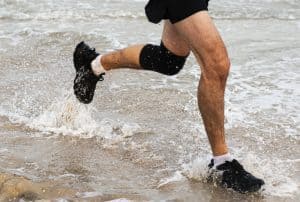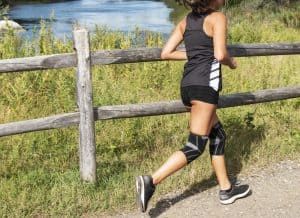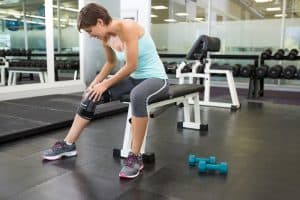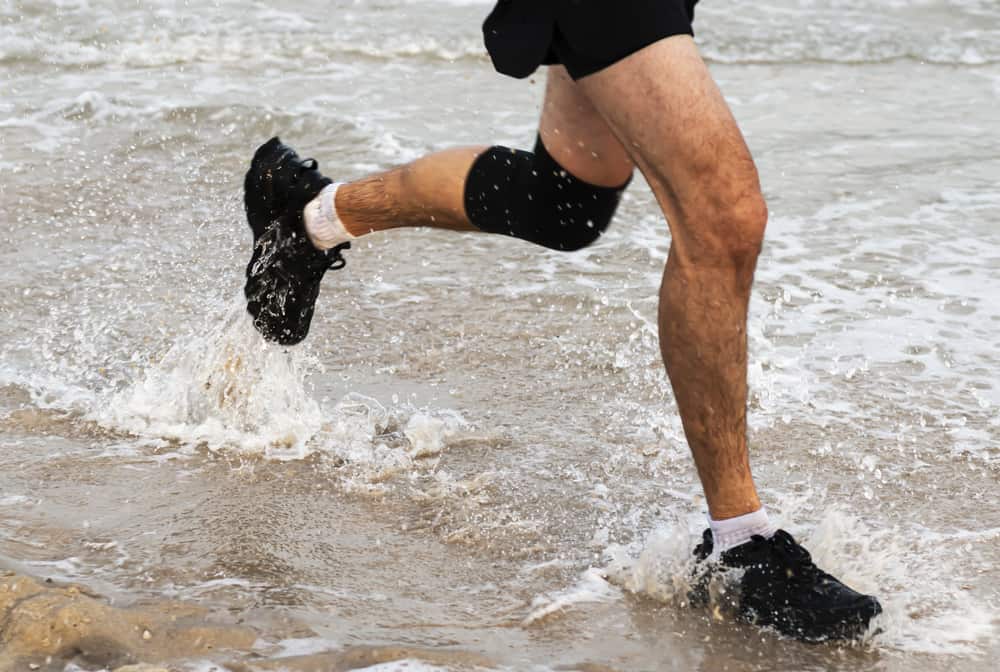Squats are underrated for how versatile they actually are. Once you master the basics, there are a bunch of ways to keep them interesting, from weights to stance shifts.
However, squatting is already hard as it is, especially for people with bad knees. Most of us are glad to take all the help we can get when it comes to supporting our joints.
So, let’s jump right in and see what benefit lies in wearing a knee brace for squats, how to pick the perfect one, and make the most out of it.

What Are Knee Braces?
Knee braces are elastic wearable bands that fit around the knee joint for prophylaxis or rehabilitation.
The stretchy material changes depending on what the braces are designed for (acute or chronic cases.) You can find different braces made from neoprene, foam, metal, or plastic.
In theory, knee braces are supposed to help with pain and reduce the risk of injuries during workout sessions.
Should You Wear a Knee Brace for Squats?
Before we dig deeper into how knee braces work and how you can choose one, let’s cover one thing first: Are squats bad for your knees?
No, in the correct form, squatting won’t hurt your knee joints.
People are often concerned about their patellas and ACLs during squats. Yet, even people with Total Knee Arthroplasty (TKA) can handle a 100° squat.
Sure, there’s always a risk of ACL tearing as you bend your knees down towards your toes.
However, the hamstrings reduce the tension on the ACL down to about 6% of its tensile capacity during squats.
In short, squats aren’t the scary, tendon-ripping monster that they’re rumored to be.
Benefits of Wearing Knee Braces
If squats aren’t that dangerous, to begin with, why bother with knee braces?
As it turns out, squats aren’t inherently bad for your knees. Yet, knee wraps, sleeves, and braces are only getting more popular.
Don’t believe us? Go ahead and walk into any gym and start counting how many people are out there wearing knee support.
There’s a wide scope of reasons people might want to wear braces for squats, from knee pain relief to form correction.
Here are some of the top benefits that you can get with a bracing knee sleeve:
- Joint pain relief
- Reduce swelling
- Injury prevention
- Speeds up recovery
How Knee Braces Work
Although some people might find knee sleeves, wraps, and braces to be a bit gimmicky, there’s quite some science backing them up.
As it turns out, supporting gadgets like a sleeve can help your form in more than one way.
Let’s check out some of the mechanisms behind using knee support during workout sessions:
Improves Proprioception
Proprioception (also known as kinesthesia) is a form of somatosensation that relates to our ability to track every muscle’s movements, spatial location, and external stimulus.
This all happens thanks to muscle spindles, Golgi tendons, and low-threshold mechanoreceptors.
Together, these proprioceptors help gather information from the muscles, tendons, and joints.
Ditching all the technical jargon aside, we can say that somatosensation translates information like temperature, nociception, balance, pressure, and even vibration to keep us within a healthy range of movements.
Sometimes, with chronic knee injuries, you might suffer from reduced proprioception. This can lead to even more damage because you no longer have the inhibitory sense that tells you when you’re pushing your limits too far.
It’s a loop of repetitive knee injury when you think about it.
Some studies have found that wearing knee braces can help with positive alterations in proprioception. All in all, this can lead to lower injury risk, especially for athletes.
In some cases, knee sleeves and braces can also help proprioceptive prophylaxis by restricting the joint movement beyond its natural scope.
Provides Structural Support
Besides helping with your proprioception, knee support braces can reduce the pain you feel around your joints during squatting, lifting, or even just walking.
The supporting knee wrap can take some pressure off your joints and redistribute it. That’s the most common reason why healthy athletes might wear knee sleeves.
Compression knee sleeves are notorious for their effect on pressure and pain. They can also decrease the tension in your quadriceps during weighted squats.
In a way, they help people with arthritis by preventing overuse injuries. Plus, patients recovering from a joint injury could use the extra support to boost the healing processes.
Of course, in these cases, a physician usually prescribes the required level of support and how long the patient needs to wear the supportive brace.
For instance, you might be required to wear knee support after an anterior cruciate ligament (ACL) injury.
Types of Knee Braces

According to the Journal of the American Academy of Orthopedic Surgeons AAOS, there are four main types of knee braces to consider.
Not all of those braces can be worn for squatting sessions since they come in different degrees of joint restriction and support.
Let’s take a closer look at each type before we can decide which one works best:
Rehabilitative (Post-Op) Braces
Rehabilitative knee braces can be one of the most restricting wearables out there, just shy of a cast. It usually has metal hinges and bars, which can be quite uncomfortable.
The main aim of these braces is to help improve the gait pattern after major knee surgeries by limiting the range of motion around the joint.
This intense movement restriction comes in handy after knee surgeries. Usually, a physician prescribes one for a range between 2-8 weeks as a protective measure.
Although they can limit joint movements, rehabilitative braces still need to be roomy enough. After all, most patients will experience some post-op swelling.
As a plus, they can be used in conjunction with rehabilitative physical therapy sessions to reduce pain.
However, they aren’t flexible enough to use for squatting support if you’re a healthy athlete.
There’s a wide range of procedures that require wearing a knee bracing band, including injuries and tears in:
- Medial collateral ligament (MCL)
- Anterior cruciate ligament (ACL)
- Posterior cruciate ligament (PCL)
- Lateral collateral ligament (LCL)
- Meniscus cartilage
Functional Braces
Functional braces are often thought of as an external ligament that allows injured ligaments to heal.
It’s usually a combination of metal bars and foam liners to offer a balance between stability and comfort.
Functional braces can be used for the same range of injuries as rehabilitative ones like the MCL, ACL, PCL, and LCL.
However, functional braces are less restrictive and are used for minor cases and not as post-op protective measures.
They also typically work for longer periods, and they’re common among football and soccer athletes.
You’ll still need a medical consultation before using these braces for the size fitting, if nothing else. So, it wouldn’t be a smart idea to use those for squats or lifting sessions.
Unloader Braces
Unloader braces use three points of support over the thigh, calf, and knee. These stability points shift the weight from one side to the other.
These braces are more common for seniors since they’re more susceptible to unicompartmental osteoarthritis, a condition that requires “unloading” the extra weight from the knees.
In fact, using an unloader bracing support for prolonged periods can eliminate the need for knee replacement surgery in some cases!
If unloaders are such great gadgets, does this mean that you wear them while you complete your daily squats?
Well, we wouldn’t recommend using an unloader without medical supervision.
It drastically redistributes the weight to the opposite side in a way that could cause more harm than benefit if you didn’t need it in the first place.
Even people who resort to unloaders as a long-term treatment protocol still have trouble tolerating the restrictive braces.
Odds are, you probably don’t want to put yourself through this just as workout prophylactic gear.
Prophylactic Braces
Prophylactic sleeves are common among athletes who practice high-risk contact sports or do powerlifting.
All in all, they don’t offer the strongest support, but they still can reduce the chances of a painful MCL injury.
Unlike the previous bracing types, these can prevent injuries during squats without necessarily needing a prescribing physician.
They’re typically much less restricting than functional rehabilitating braces. Still, they could have bars, hinges, and adhesive straps that are more complex than lightweight knee sleeves.
There are different shapes for support bands that could be used for prophylaxis, from compression sleeves to soft pads, but we’ll get to those in a minute.
Knee Sleeves, Knee Pads, Knee Wraps, and Knee Straps: What’s the Difference?
Okay, so you want to give bracing a chance, but you don’t feel like going for an extreme option with metal bars and hinges.
In that case, you’ll find way too many shapes and forms out there that could seem a bit overwhelming.
Some of them are tightened with velcro, others look like large bracelets, while the majority look like a wide elastic sleeve.
Let’s take a look at your prophylactic options:
Knee Sleeves
A knee sleeve is usually thinner than a typical brace, and it offers a wider range of joint movements.
That’s because knee sleeves lack the structured support of metal or plastic bracing. Instead, they work to reduce painful stabs mainly by compression.
This kind of sleeve works best for people with chronic conditions since they’re lightweight, comfortable, and less restricting.
As a plus, many people find that wearing a knee compression sleeve provides warmth that keeps the blood flowing smoothly in and out of the joint.
The particular appeal of using a knee sleeve is how easy it is to slip it on versus some intricate braces that require adjustable straps and hinges.
Knee Pads
Other support bands are heavily padded, and it doesn’t offer the highest stability and proprioception enhancement.
It might not be ideal for squats, but you might find it suitable for sports with high impact risk since it offers protection and comfort.
You’ll even notice that fluffy pads feel a lot like the protective gear people use for skating or biking.
Knee Wraps
The design of knee wraps makes them ideal for compression and stability since they’re usually made of stretchy fabric around 72 inches long.
The breathable material on these knee accessories is a lot similar to the weightlifting wrist wraps that you can get in any pharmacy.
The kind of support you get with compression knee wraps works well with weight lifting and squatting.
The reason why knee wraps are good for powerlifting is that they help reduce the barbell displacement, making the lift more force-efficient.
However, they can also take over your quad function by offering too much stability. This reduction in quad activation can go for up to a whopping 90%!
That’s great news if you’re seeking pain relief, but not so much if you want to quickly build up muscle mass.
They’re also not the easiest in terms of usage since you have to nail down your wrapping technique to get the maximum benefit. Some people do spiral wraps, while others prefer the cross technique.
Knee Straps
Unlike a sleeve or a wrap, a knee strap doesn’t provide full coverage for the knee joints. Instead, it’s just a stretchy band that goes over the leg, right under the kneecap.
You might be interested in knee bands if you suffer from patellar problems like patellar tendonitis, Osgood-Schaller disease, and chondromalacia patella.
When worn properly, they apply pressure, just like a compression sleeve, but on a specific tendon connecting the kneecap to the shinbone.
In essence, it just tightens up the knee’s natural mechanisms to relieve anterior patellar pain while squatting or bending.
Choosing the Best Knee Brace for Squats

It can be tough deciding which knee support works best for you.
Here are some tips and tricks that can guide you:
1. Know Your Needs
As we’ve covered, there’s a wide range of bracing options to choose from. Depending on your needs, you’ll want to balance structural support, compression, and warmness.
For simple prophylaxis during squats, you might want to start with a basic sleeve, but for more serious cases, you’ll need to consult your physician about your options.
You’ll also need to consider the ease of use since some wraps or hinged braces can be tricky to put on and tighten properly.
2. Get the Right Size
When you’re picking a supporting gear like knee sleeves, the key is to find the perfect fit. It needs to be snug enough without cutting off your circulation.
You also don’t want the lining fabric to pinch your skin or scuff the delicate area behind your knees.
Some brands save you the hassle by creating one-size-fits-all products, but you might not get the best results from those if you’re not an average weight.
One way to ensure a nice fit is to measure around your knees and compare it to the product. Just make sure you’re measuring around the widest portion (the knee cap) during extension.
If you’re recovering from an injury or surgery, you might notice changes in size due to swelling. So, we would recommend talking to your physician about the fitting.
In complicated cases, you might need to splurge on a custom-made pair. However, for simple prophylaxis, pre-sized ones will do just fine.
3. Find a Comfortable Lining
Just because a bracing sleeve is the right size doesn’t mean that it’s going to be a perfect fit. Your comfort matters too!
Sometimes, knee braces can have an inner seam that can rough the skin up or itchy lining material.
Remember, if it’s not comfortable, you’ll never bear to wear it regularly, and the key to recovery is consistent use.
So, make sure you run your hands inside the sleeve a couple of times to check for any potential irritants.
This is particularly useful for people who wear knee support for a prolonged period or elders with sensitive, thin skin.
4. Test Your Mobility Limits
Even if you get the right bracing style, closure form, and size, you still need to test the sleeve or wrap before you go ahead and start your gym workout.
For the most part, knee sleeves allow a decent range of joint movements needed for exercising and doing squats.
However, every now and then, a sleeve might still feel too restricting around your knees. In this case, pushing through the uncomfortable sensation could do more harm than good.
If you’re prescribed hinged braces, and you don’t feel like your joints have enough freedom to bend, you might have to put it off for now.
Instead, you can start with simple physical therapy exercises till you’re ready to take the bracing off. You don’t want to push your mobility beyond your capabilities too much.
5. Treat Yourself to Extra Features
Sometimes, you can use an extra feature or two to boost your experience from any given sleeve or bracing support.
For instance, some brands add in a vibrating feature or a built-in heater. Together, they work nicely to relieve osteoarthritis.
Be careful, though. The result feels more like a relaxing massager than workout gear. You might end up skipping the session altogether.
On the other hand, some sleeves come with pockets for cooling pads, which can help reduce swelling post-workout.
Maintaining Proper Squatting Form

Squats sound simple enough. You dip down as deep as you can and then get right up.
However, you’d be surprised at how wrong people do their squats if they’re not aware of the correct squatting form.
Have you ever been taught how to squat? If not, you might be doing it wrong and risking a potential injury.
Let’s take a look at the correct form:
Fix Your Starting Posture
To do squats the right way, you need to start with an upright posture, broaden your chest, and hold your head high.
Keep your feet slightly wider than your shoulder span and shift your weight off to the balls of your heel.
Make sure your hips are leveled and pull your shoulders back to avoid arching your spine forward.
Keep Your Feet Down Firmly
Sometimes, when you’re rising, from a squat you’ll feel your toes lifting off the ground ever so slightly. This puts your weight off balance.
Try to keep your entire foot (toes to heel) in touch with the ground and turn it outwards 30° for a firmer hold.
Warming up your calf muscles can also give you a flexibility boost that could keep you down. If not, then you might need squat-specific shoes weighted on the heel and toe box.
Don’t Over Arch Your Back
For some reason, people tend to arch their back forward as they dip into the squat, which ends up putting unnecessary pressure on your spine.
You need to practice keeping your back straight as you squat, just like your neutral standing posture.
If you can’t do it intrinsically, doing wall squats for a while can help you unlearn this arching habit.
Start With Simple Exercises
There are many ways to spice squats like barbells, dumbbells, wide stances, and machine squats.
For a beginner, we would recommend starting with basic bodyweight squats before moving on to more complex exercises.
They’re still a compound movement that can boost your fitness without putting too much strain on your joints.
Never Lock Your Knees
As is the case with any repetitive motion, you risk locking your knee joints during the squat, which puts your tendons at even more risk.
Remember that there are so much more muscles and joints at work than just your knees.
If you lock your knee out, you’ll shift all the weight from your muscles to that one joint. Instead, you want to make sure your knees are free to move at all times.
Engage Your Core
Keeping your abs engaged can help you make the most out of your squats and help with weight distribution.
Plus, using your core muscles can also help you keep your knees leveled without exceeding your toe line as you’re bending down.
Not only should you involve your abs, but you’ll also need to engage your quadriceps, glutei maximi, calves, hamstrings, and obliques. Remember: squats are compound movements!
Breathe Rhythmically
It’s easy to get lost in the exercise so much that you lose focus of your breathing, and you don’t want that.
Instead, try taking in a deep breath that fills your stomach right before dipping down into the squat.
As you begin extending your knees to get up, exhale gradually till you’re standing upright once again. Rinse and repeat.
Knee Brace for Squats FAQs
Here are some of the frequently asked questions regarding squatting and knee support gadgets:
Q: Is it normal for my knees to crack when I squat?
A: Sometimes, even young and healthy people will notice that their joints crack when they bend them.
Cracking on itself isn’t an alarming symptom. However, if it’s accompanied by pain and swelling, it might be time to get a check-up.
Q: Can you use knee braces for running?
A: Yes, compression knee sleeves work for more than just squats. You can use them for running, jogging, and powerlifting.
Bracing works, in the same way, to provide structural support, improve circulation, and enhance proprioception.
Q: Do you need to wear a knee brace to bed?
A: A knee brace provides excellent support whenever you’re out of bed since this is when you’re in most need of a proprioception boost.
So, unless you’re directed otherwise by a physician, we wouldn’t recommend wearing your braces to sleep. It could put you at risk of muscle stiffness.
Q: Who needs a custom knee brace?
A: Getting customized braces can take time, and it’s way more expensive than getting a pre-sized band.
In most cases, you don’t need to consider customized options unless a physician prescribes one for post-op rehabilitative purposes.
Q: When to skip the squats altogether?
A: Some severe cases of back and knee injuries affect mobility beyond the scope of squats.
If a professional health care provider tells you that squats aren’t for you, it’s time to consider alternative leg exercises like a leg press, lunges, glute bridges, and hip hinges.
Final Thoughts On Choosing The Best Knee Brace for Squats
All in all, wearing a knee brace for squats can help improve proprioception and provide adequate structural support. The key is finding one with the right size, style, and mobility range.
However, you need to keep in mind that knee sleeves and braces will only do so much to protect your joint.
Make sure you follow a proper form and give your body a chance to heal between workout sessions.

